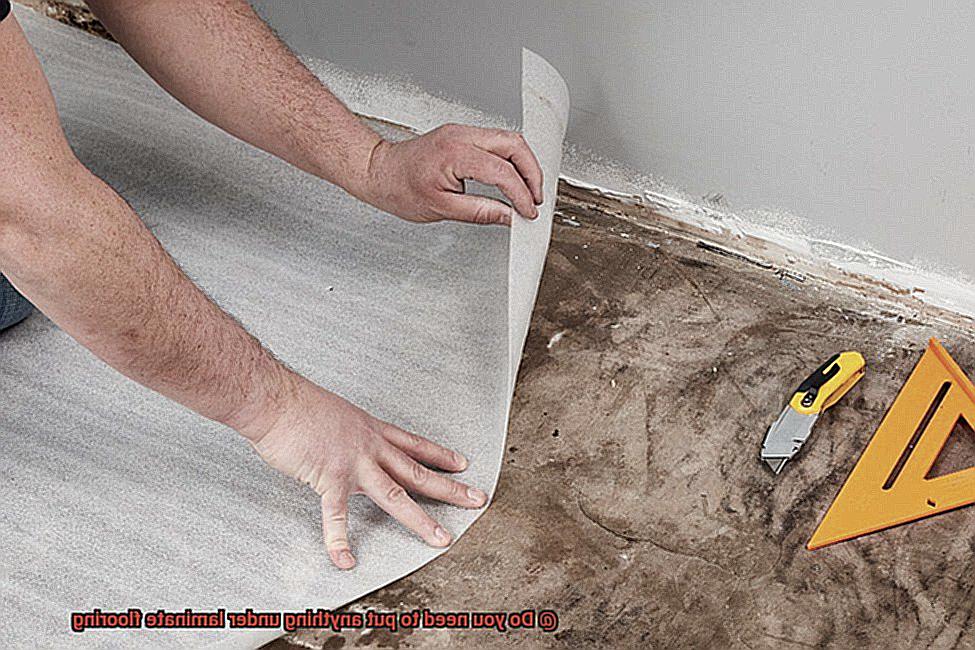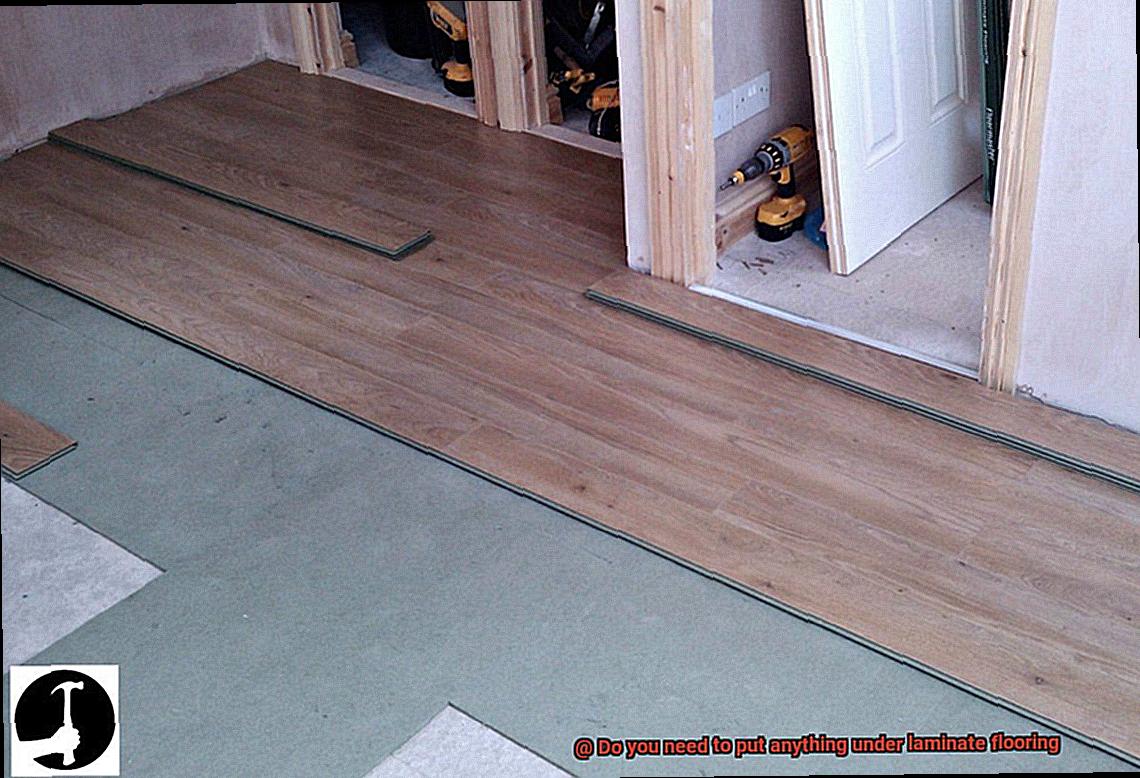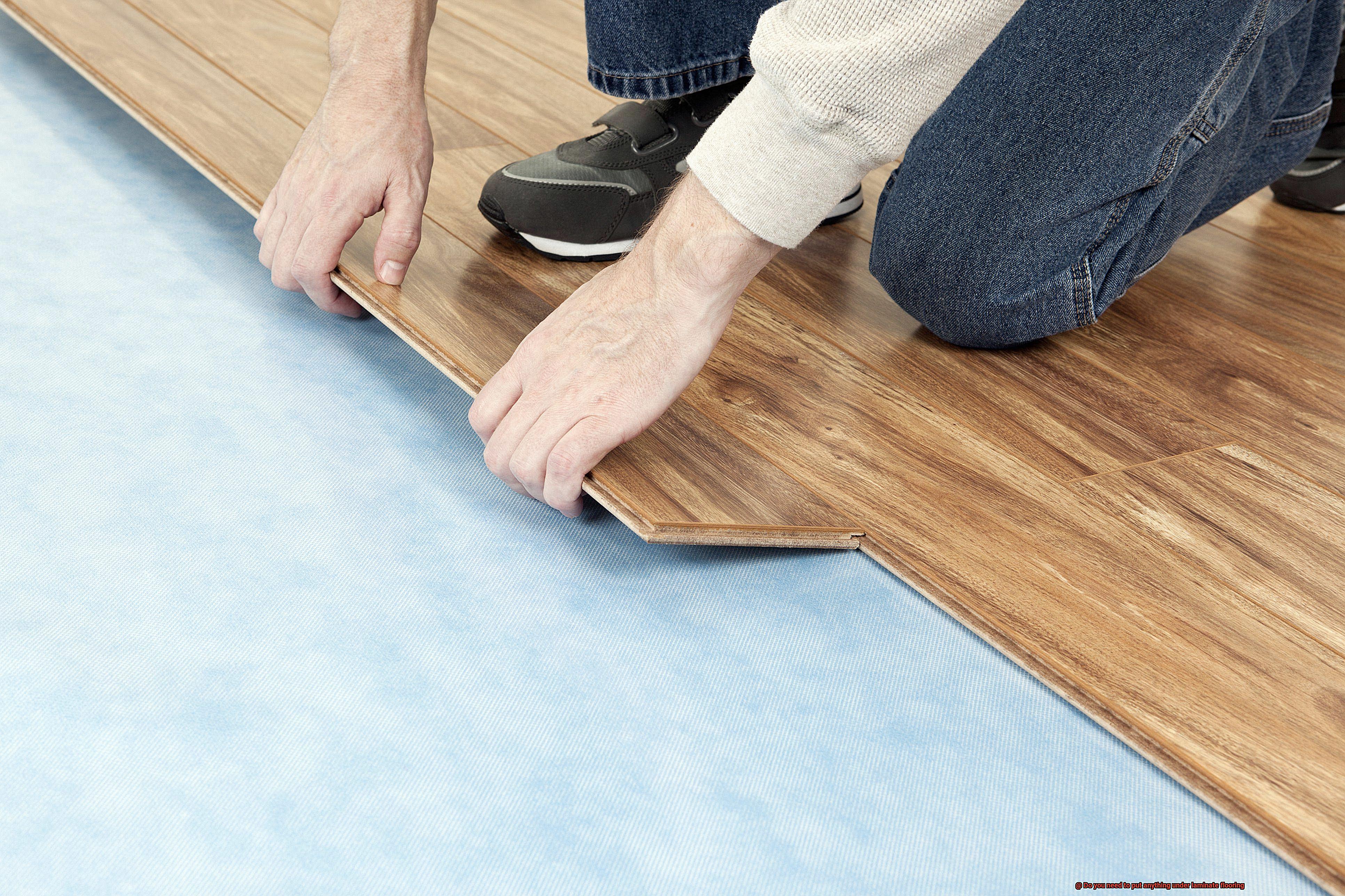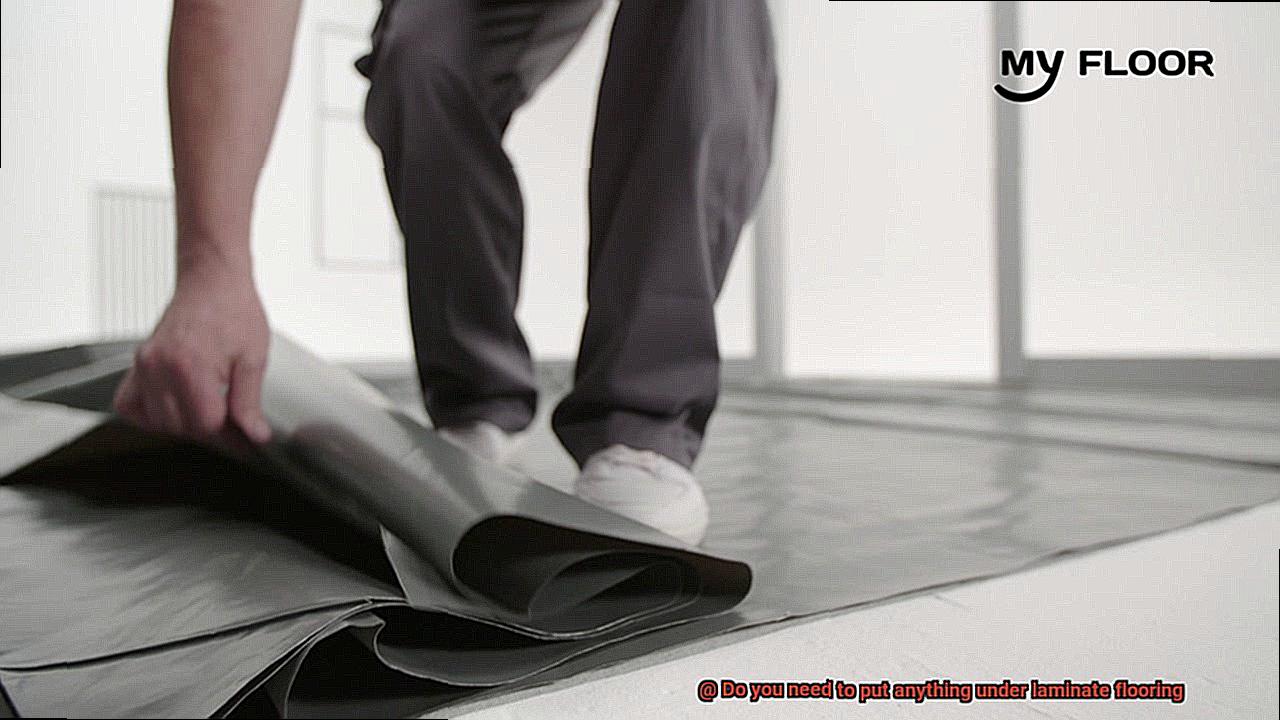Are you scratching your head over whether or not to use an underlayment for your laminate flooring? Don’t worry, we’ve got you covered. In this blog post, we’re going to dive deep into the question of whether or not you need to put anything under laminate flooring.
Think about it – would you build a house without a foundation? No way. The same goes for laying down laminate flooring. Skipping the underlayment step could lead to a host of problems like buckling, shifting, and uneven floors.
But don’t fret just yet. We’ll walk you through why an underlayment is necessary for laminate flooring and explore the different types of underlayment available. Plus, we’ll give you some tips on how to choose the best one for your floor.
But wait, there’s more. We’ll also take a look at some common mistakes people make while installing underlayment and show you how to avoid them.
If you’re planning on installing laminate flooring anytime soon, this is definitely a must-read. So buckle up and get ready to discover why and how you should put an underlayment under your laminate flooring. Trust us, it’s worth it in the end.
Do You Need to Put Anything Under Laminate Flooring?
Contents
- 1 Do You Need to Put Anything Under Laminate Flooring?
- 2 What Type of Subfloor Should be Used for Laminate Flooring?
- 3 Benefits of Using a Subfloor with Laminate Flooring
- 4 What is an Underlayment and How Does it Help with Laminate Flooring?
- 5 Types of Underlayments for Laminate Flooring
- 6 How to Choose the Right Subfloor and Underlayment for Your Project
- 7 Preparing the Subfloor Before Installing Laminate Flooring
- 8 Installing the Subfloor and Underlayment
- 9 Conclusion
The answer is yes, but it’s not a one-size-fits-all solution. There are several factors to consider before deciding on the type of underlayment needed for your specific project.
So, what exactly is an underlayment? It’s a thin layer of material that sits between the subfloor and the laminate flooring. Its primary function is to provide a stable and even surface for the planks to sit on, as well as to offer additional benefits such as sound insulation and moisture protection.
If you’re installing laminate flooring over a concrete subfloor, an underlayment with built-in moisture protection is essential. Concrete subfloors are prone to moisture, which can lead to damage to the laminate planks over time.
On the other hand, if your subfloor is made of wood, you may or may not need an underlayment depending on its condition. If the wood subfloor is level and in good condition, then it’s possible to install the laminate planks directly on top of it. However, uneven or damaged wood subfloors will require an underlayment to create a smooth and level surface.
In addition to the type of subfloor, it’s crucial to follow the manufacturer’s specific requirements when choosing an underlayment. Some laminate products come with pre-attached underlayment, while others require a separate one to be installed. Always consult the manufacturer’s instructions before starting your installation.
What Type of Subfloor Should be Used for Laminate Flooring?
The subfloor is a crucial component that ensures your laminate flooring stays intact and looks great for years to come. Let’s explore the different types of subflooring that are best suited for laminate flooring.
First on our list is plywood subflooring. Plywood is a versatile and durable material that makes it easy to work with. It can also be sanded down to create a smooth surface for your laminate flooring. However, plywood is prone to warping if it gets wet, so it’s essential to ensure that the area where you’re installing your laminate floor is dry and free from moisture.
Another option is oriented strand board (OSB) subflooring. OSB is similar to plywood but made from smaller pieces of wood glued together. It’s also less expensive than plywood, making it an excellent option for those on a budget. However, like plywood, OSB can warp if exposed to moisture.
If your subfloor is concrete, you’ll need to use a moisture barrier to prevent any moisture from seeping through and damaging your laminate flooring. A plastic sheet or vapor barrier can be used for this purpose.
No matter what type of subfloor you choose, it’s essential to make sure it’s level and free from any bumps or irregularities. This step will ensure that your laminate flooring stays in place and looks great over time.
In conclusion, choosing the right type of subflooring is crucial when installing laminate flooring. Plywood and OSB are popular options, while a moisture barrier is necessary when installing over concrete. Make sure your subfloor is level and free from imperfections before laying down your laminate flooring. With these tips in mind, you can confidently install laminate flooring that will last for years to come.
Benefits of Using a Subfloor with Laminate Flooring
If you’re looking to give your home a fresh, new look with laminate flooring, you may be wondering if using a subfloor is worth the extra effort. The answer is a resounding “yes.” Here are some of the benefits of using a subfloor with laminate flooring.
Firstly, using a subfloor can help level out any imperfections in your existing flooring. This is essential because laminate floors require a flat and even surface to be installed on. With a subfloor in place, any bumps or dips in your old floor will be evened out, ensuring that your new laminate flooring looks polished and professional.
In addition to creating a level surface, using a subfloor can also help reduce noise and provide insulation. Laminate flooring can sometimes produce a hollow sound when walked on, especially in rooms with high ceilings. A subfloor helps to absorb some of this sound and make the flooring feel more solid underfoot. Plus, it provides an extra layer of insulation that can keep your home warmer in winter while lowering your energy bills.
Lastly, using a subfloor can make the installation process easier and more efficient. With a subfloor in place, the planks of laminate can be easily clicked together and secured without the need for glue or other adhesives. This not only saves time and money on installation costs but also makes it easier to replace damaged planks in the future.
What is an Underlayment and How Does it Help with Laminate Flooring?

You might be wondering about the role of underlayment in this process. Simply put, underlayment is a layer of material that sits between the subfloor and the laminate flooring. It is an essential component that can significantly improve the performance and longevity of your new floors.

Here are some key reasons why underlayment is so crucial:
- Stability: Underlayment provides a smooth and level surface for your laminate flooring to rest on. By absorbing any minor imperfections in the subfloor, it prevents them from showing through or causing damage to the laminate flooring. This means that your floors will look polished and even for years to come.
- Noise reduction: Do you want to reduce the amount of sound that travels through your floors? Underlayment acts as a sound barrier between the subfloor and the laminate, which can help to make your home quieter and more peaceful.
- Moisture protection: Underlayment provides a barrier against moisture, which is especially important in areas like bathrooms or basements where moisture levels can be high. By preventing moisture from seeping into the laminate flooring and causing damage, underlayment helps to ensure that your new floors last longer.
- Thermal protection: Underlayment can help to increase the insulation of your home by providing an additional layer of thermal protection. By reducing heat loss during colder seasons, underlayment can make your home more comfortable and energy-efficient.
Types of Underlayments for Laminate Flooring
When it comes to laminate flooring, the underlayment is a crucial component that should not be overlooked. It serves as a protective layer between the subfloor and the laminate flooring, providing support, cushioning, sound insulation, and moisture resistance. There are different types of underlayments available on the market, each with its unique benefits and features. Let’s explore them in more detail.
Foam underlayment is the most popular and affordable option for laminate flooring. It is made from polyethylene or polypropylene foam and is easy to install due to its lightweight nature. Foam underlayment provides excellent noise reduction properties and insulation against cold floors, making it a great choice for most homes.
Cork underlayment is another fantastic option for those who prioritize eco-friendliness and superior insulation. The material is made from compressed cork granules and provides excellent sound absorption and thermal insulation. It is also hypoallergenic, moisture-resistant, and comfortable to walk on.

Rubber underlayment is perfect for high-traffic areas as it offers exceptional durability and cushioning. Made from recycled rubber materials, this underlayment type provides excellent sound insulation and moisture protection while withstanding heavy foot traffic. Although it’s more expensive than foam underlayment, it offers long-term value.
Felt underlayment is a traditional option that has been used for many years in homes with hardwood floors. It is made from recycled fibers and offers excellent insulation against cold floors and good sound absorption properties. However, it may compress over time and isn’t as durable as other options.
Combination underlayment blends different materials such as foam and rubber or felt and cork to create an overall better experience. This type of underlayment provides all the benefits of multiple materials, including superior sound insulation, cushioning, and moisture protection.
How to Choose the Right Subfloor and Underlayment for Your Project
Selecting the perfect subfloor and underlayment for your laminate flooring project is a critical step in ensuring a smooth installation that will last for years to come. Here are five key factors to consider when choosing the right subfloor and underlayment for your project:
Room Type
The first factor to consider is the type of room where you’ll be installing laminate flooring. High-traffic areas such as hallways, kitchens, and living rooms require a sturdier subfloor and underlayment to ensure durability over time. On the other hand, spaces with less foot traffic such as bedrooms or guest rooms can get by with a thinner underlayment.
Moisture Levels

Moisture levels are another crucial factor to consider when choosing a subfloor and underlayment. If you’re installing laminate in areas that are prone to moisture such as basements or bathrooms, it’s essential to choose a moisture-resistant subfloor and underlayment to prevent warping or damage.
Type of Underlayment

The type of underlayment you choose can also make a significant impact on the final outcome of your project. Foam underlayment is the most common choice because it’s affordable and easy to install. Cork underlayment is an eco-friendly option that provides excellent sound insulation. Rubber underlayment is more expensive but offers superior impact resistance and moisture protection.
Underlayment Thickness
The thickness of your underlayment will depend on the level of foot traffic in the room. For areas with low foot traffic, a thinner underlayment may be sufficient. However, for high traffic areas, it’s ideal to choose a thicker underlayment for added cushioning and sound insulation.
Manufacturer Recommendations
It’s always best to check with your laminate flooring manufacturer for any specific recommendations on the type of subfloor and underlayment to use with their products. Some manufacturers may recommend a particular type of underlayment to ensure a successful installation and maintain warranty coverage.

Preparing the Subfloor Before Installing Laminate Flooring
Before you get started, it’s crucial that you properly prepare your subfloor to ensure a flawless and secure installation. As an expert on this subject, I can tell you that taking the necessary steps to prepare your subfloor will make all the difference in achieving beautiful and durable laminate flooring.
First and foremost, begin by ensuring that your subfloor is clean and free of any debris. Sweep or vacuum up any dirt, dust, or other materials that could interfere with the installation process. High spots and low spots on the subfloor can also be leveled out using a self-leveling compound.
In addition to cleanliness, moisture levels in the subfloor should also be checked. Laminate flooring is not waterproof, so it’s vital to make sure that your subfloor isn’t too moist. Use a moisture meter to measure the moisture content of the subfloor, and if the levels are too high, an additional vapor barrier may need to be installed.
Structural integrity is another important factor to consider when preparing your subfloor. Your subfloor must be strong enough to support the weight of your new laminate flooring as well as any furniture or foot traffic that will be present. If there are any areas of damage or weakness, it may be necessary to reinforce the subfloor before installing the laminate.
Finally, an underlayment may be necessary for some laminate flooring installations. This layer provides extra cushioning and soundproofing for your new floors while also helping to level out any minor imperfections in the subfloor. However, not all laminate flooring installations require an underlayment, so be sure to consult with the manufacturer’s recommendations before making a final decision.
Installing the Subfloor and Underlayment
This crucial step ensures a flawless and durable finished product that will be enjoyed for years to come.

Before beginning any installation, it is imperative to ensure that your subfloor is clean, dry, and level. Any debris or unevenness can cause issues during installation and affect the overall appearance and durability of the finished floor. Take the time to thoroughly clean and level your subfloor to ensure a solid foundation for your laminate flooring.
Once your subfloor is ready, it’s time to install the underlayment. This layer provides cushioning for your laminate flooring and acts as a moisture barrier. There are different types of underlayment available, including foam, cork, and felt. The type of underlayment you choose will depend on various factors such as the type of subfloor, the level of moisture in the room, and the desired sound insulation properties.
It is essential to follow the manufacturer’s instructions when installing both the subfloor and underlayment. Some manufacturers may require specific adhesives or fasteners to be used during installation, so it’s crucial to read and follow the instructions carefully.

Other important considerations include:
- Choosing an underlayment with a higher R-value can help increase energy efficiency.
- If you have a concrete subfloor, consider using a vapor barrier to prevent moisture from seeping through.
- Some laminate flooring products come with an attached underlayment, which eliminates the need for a separate installation. However, it’s still essential to ensure that the subfloor is properly prepared before installing any type of laminate flooring.
Conclusion
In summary, it’s essential to put an underlayment layer when installing laminate flooring. Neglecting this step could lead to a plethora of issues such as uneven floors, shifting, and buckling. The underlayment provides a stable and level surface for the planks to rest on while also offering sound insulation and moisture protection.
When selecting a subfloor and underlayment for your project, several factors come into play, such as room type, moisture levels, underlayment type and thickness, and manufacturer recommendations. It’s imperative to adhere to the manufacturer’s instructions when installing both the subfloor and underlayment.
A well-prepared subfloor is crucial in achieving visually appealing and long-lasting laminate flooring. This includes ensuring that the subfloor is clean, dry, level, and structurally sound. Adding an underlayment layer offers cushioning for your laminate flooring while also acting as a barrier against moisture.
By following these tips and taking the necessary steps to prepare your subfloor correctly before installation, you can confidently install laminate flooring that will stand the test of time.






